Titus facts for kids
Quick facts for kids Titus |
|||||||||
|---|---|---|---|---|---|---|---|---|---|
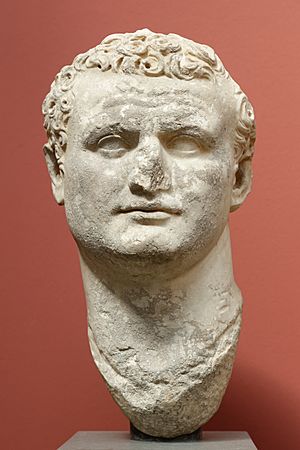
Bust at the Ny Carlsberg Glyptotek
|
|||||||||
| Roman emperor | |||||||||
| Reign | 24 June 79 – 13 September 81 | ||||||||
| Predecessor | Vespasian | ||||||||
| Successor | Domitian | ||||||||
| Born | 30 December 39 Rome, Italy |
||||||||
| Died | 13 September 81 (aged 41) Rome, Italy |
||||||||
| Burial | Rome | ||||||||
| Spouse |
|
||||||||
| Issue | Julia Flavia (by Arrecina) Flavia (by Furnilla) |
||||||||
|
|||||||||
| Dynasty | Flavian | ||||||||
| Father | Vespasian | ||||||||
| Mother | Domitilla | ||||||||
Titus Caesar Vespasianus (born December 30, 39 AD – died September 13, 81 AD) was a Roman emperor who ruled from 79 to 81 AD. He was part of the Flavian dynasty. Titus became emperor after his father, Vespasian, passed away.
Before becoming emperor, Titus was a famous military leader. He served under his father in Judea during the First Jewish–Roman War. In 70 AD, he led the attack on Jerusalem, capturing and destroying the city and the Second Temple. To celebrate this victory, Titus was given a special parade called a triumph. The Arch of Titus in Rome still stands today to remember his victory.
While his father was emperor, Titus was the leader of the Praetorian Guard. This was a special group of soldiers who protected the emperor. Even though some people worried about his personality, historians like Suetonius thought Titus was a good emperor.
As emperor, Titus is most known for finishing the Colosseum. He was also very kind and helpful during two big disasters. These were the eruption of Mount Vesuvius in AD 79 and a large fire in Rome in 80 AD. Titus ruled for only two years before he died from a fever on September 13, 81 AD. The Roman Senate declared him a god, and his younger brother, Domitian, became the next emperor.
Contents
Early Life and Family
Titus was born in Rome, probably on December 30, 39 AD. He was the oldest son of Vespasian and Domitilla the Elder. He had a younger sister, Domitilla the Younger, and a younger brother, Domitian.
Titus's Family History
Titus's great-grandfather, Titus Flavius Petro, was a soldier who served under Pompey. His military career ended sadly when he ran away from a battle.
However, Petro's family status improved. He married a very rich woman named Tertulla. Her money helped their son, Titus Flavius Sabinus I, become successful. Sabinus worked as a tax collector and banker. He married Vespasia Polla, connecting his family to a more important Roman family. Their sons, Titus Flavius Sabinus II and Vespasian, became senators.
Vespasian became a consul in 51 AD. This was the same year Domitian was born. Vespasian also fought in the Roman invasion of Britain in 43 AD. We know little about Titus's early life. Historian Suetonius wrote that Titus grew up in the emperor's palace. He was friends with Britannicus, the son of Emperor Claudius. Britannicus was later killed by Nero in 55 AD.
Titus showed early talent in military skills. He was also a good poet and speaker in both Greek and Latin.
Titus's Adult Life
From about 57 to 59 AD, Titus was a military officer in Germania. He also served in Britannia. He might have arrived there around 60 AD with extra soldiers needed after a revolt led by Boudica. Around 63 AD, he returned to Rome. He married Arrecina Tertulla, whose father was a former leader of the Praetorian Guard. She passed away around 65 AD.
Titus then married Marcia Furnilla. Her family was connected to people who opposed Emperor Nero. Some historians think Titus divorced Marcia because of her family's links to a plot against Nero.
Titus did not marry again after Marcia. He had several daughters, and at least one, Julia Flavia, lived to adulthood. During this time, Titus also worked as a lawyer and became a quaestor, a type of Roman official.
The Jewish War Campaigns
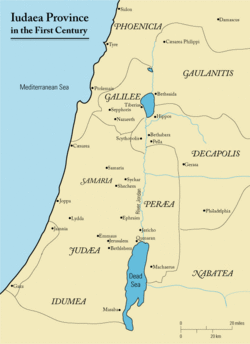
In 66 AD, the Jewish people in the Judaea Province started a rebellion against the Roman Empire. The Roman governor of Syria was defeated and had to leave Jerusalem. Emperor Nero sent Vespasian to stop the rebellion. Vespasian went to the region with two Roman legions. Titus joined him later with a third legion. With 60,000 trained soldiers, the Romans planned to take over Galilee and march on Jerusalem.
A Roman-Jewish historian named Josephus wrote a detailed history of this war. Josephus was a commander in the city of Yodfat when the Roman army attacked Galilee in 67 AD. After a long siege of 47 days, the city fell. About 40,000 people were killed. Josephus surrendered to Vespasian and became a prisoner. He later said he gave the Romans information about the rebellion. By 68 AD, the Roman Army had taken control of the entire coast and northern Judaea. Titus showed himself to be a skilled general in these battles.
The Year of Four Emperors
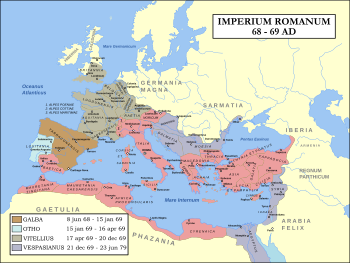
The last strong city held by the Jewish rebels was Jerusalem. The Roman campaign stopped suddenly when news arrived that Emperor Nero had died. The Roman Senate then named Galba, a governor, as the new emperor. Vespasian decided to wait for new orders and sent Titus to meet the new emperor.
Before reaching Italy, Titus learned that Galba had been killed. Otho had replaced him, and Vitellius was preparing to march on Rome to overthrow Otho. Titus did not want to be caught between these sides. He went back to his father in Judaea. Meanwhile, Otho was defeated and died.
When the armies in Judaea and Egypt heard this, they declared Vespasian emperor on July 1, 69 AD. Vespasian agreed. He joined forces with the governor of Syria. A strong Roman force marched on Rome, and Vespasian went to Alexandria. He left Titus in charge of ending the Jewish rebellion. By the end of 69 AD, Vitellius's forces were defeated. The Senate officially declared Vespasian emperor on December 21, ending the Year of the Four Emperors.
The Siege of Jerusalem
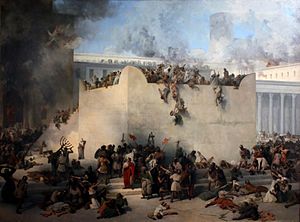
Meanwhile, the Jewish rebels in Jerusalem were fighting among themselves. Titus began to besiege Jerusalem. The Roman Army surrounded the city. Titus put pressure on the city's food and water supplies. He let pilgrims enter the city for Passover but then would not let them leave. Jewish raids often bothered the Roman army, and Titus himself was almost captured once.
Josephus tried to get the rebels to surrender, but they refused. The Romans then attacked and quickly broke through the city's first two walls. To scare the rebels, Titus ordered that Jewish deserters be crucified around the city walls. By then, the Jewish people were suffering from hunger. When the third wall was broken, fierce street fighting began.
The Romans finally captured the Antonia Fortress. They then attacked the gates of the Second Temple. As they broke through, the Romans set fire to parts of the city. This ended with the destruction of the Temple. After the fires died down, Titus ordered the rest of the city to be destroyed. His soldiers cheered him as "imperator" for the victory.
Jerusalem was sacked, and many people were killed or scattered. Josephus claimed that 1,100,000 people died during the siege. Modern historians believe this number is too high. However, 97,000 people were captured and enslaved. Many Jewish people fled to other areas around the Mediterranean Sea. Titus reportedly refused a victory wreath. He said he had not won the victory alone but was a tool for God's anger against his people.
According to Josephus, Jewish people were living in Parthia (Persia), Babylonia (Iraq), and Arabia after the Temple's destruction. Some were also beyond the Euphrates River and in Adiabene (Kurdistan).
Titus as Heir to Vespasian
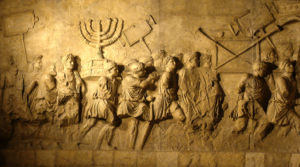
Titus could not sail to Italy during the winter. So, he held special games in Caesarea and Berytus. He then traveled to Zeugma, where the king of Parthia gave him a crown. While visiting Antioch, he confirmed the traditional rights of the Jewish people in that city.
On his way to Alexandria, he stopped in Memphis to honor a sacred bull. According to Suetonius, this caused concern because the ceremony required Titus to wear a crown. Romans linked crowns to kingship, and some feared Titus might rebel against his father. Titus quickly returned to Rome to calm any suspicions.
When he arrived in Rome in 71 AD, Titus was given a triumph. He rode into the city with Vespasian and Domitian. The Roman people cheered loudly. A grand parade showed treasures and captives from the war. Josephus described a procession with much gold and silver. It included re-enactments of the war, Jewish prisoners, and treasures from the Temple of Jerusalem, like the Menorah. A rebel leader was executed in the Forum. The parade ended with religious sacrifices.
The triumphal Arch of Titus stands at an entrance to the Forum. It remembers Titus's victory.
With Vespasian as emperor, Titus and Domitian received the title of Caesar. Titus shared power with his father and served as a consul seven times. He also acted as his father's secretary. Most importantly, he was made leader of the Praetorian Guard. This made sure the Guard was loyal to the emperor.
In this role, Titus became known for his strong actions. He often ordered the execution of people suspected of treason. In 79 AD, a plot to overthrow Vespasian was discovered. Titus invited one of the plotters to dinner and had him killed before he left the room.
During the Jewish Wars, Titus started a relationship with Berenice. She was the sister of a king who helped the Romans. In 75 AD, she returned to Titus and lived with him in the palace. Romans were worried about an eastern queen and did not approve of their relationship. When people publicly criticized them, Titus sent her away. But his reputation still suffered.
Titus as Emperor
Becoming Emperor
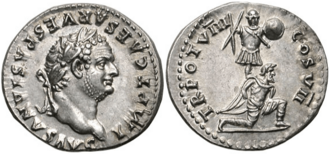
Vespasian died on June 23 or 24, 79 AD. His son Titus immediately became emperor. He was the first Roman emperor to take the throne directly from his own father. Many Romans feared Titus would be a bad emperor because of some of his past actions. However, Titus proved to be a good emperor. The people loved him and praised him for his good qualities.
One of his first actions as emperor was to stop trials for treason. These trials had caused many problems in Rome for a long time. The law of treason was meant to punish those who tried to overthrow the government. But under earlier emperors, it was used to punish people for just speaking badly about the emperor. This led to many trials and executions. People called "informers" would report others, creating fear in Rome's political system.
Because of Titus's actions, no senators were put to death during his rule. He kept his promise to keep his hands "unstained." Informers were publicly punished and sent away from Rome. Titus also made it illegal to try a person for the same crime under different laws. When Berenice returned to Rome, he sent her away again.
As emperor, Titus was known for his kindness. Historian Suetonius wrote that one day Titus realized he had not helped anyone. He then said, "Friends, I have lost a day."
Challenges During His Rule
Titus's short rule did not have many major wars or political fights. However, he faced several big disasters. A few months after he became emperor, Mount Vesuvius erupted. This eruption almost completely destroyed cities and towns around the Bay of Naples. The cities of Pompeii and Herculaneum were buried under ash and lava, killing thousands. Titus sent two former consuls to help organize relief efforts. He personally gave a lot of money from the imperial treasury to help the victims. He visited Pompeii once after the eruption and again the next year.
During his second visit, in the spring of 80 AD, a fire broke out in Rome. It burned large parts of the city for three days and nights. While not as bad as the Great Fire of Rome in 64 AD, many important public buildings were destroyed. These included the Pantheon and the Temple of Jupiter. Again, Titus personally paid to help repair the damaged areas. According to Suetonius, a plague also happened during the fire.
Meanwhile, fighting continued in Britannia. A Roman general named Gnaeus Julius Agricola pushed further north and built several forts. Because of his actions, Titus received the title of "imperator" for the fifteenth time.
His reign also saw a rebellion led by Terentius Maximus. This was one of several "false Neros" who appeared during the 70s. Terentius Maximus looked and sounded like Nero. He gained followers in Asia Minor but was soon forced to flee. Also, sources say that Titus found out his brother Domitian was plotting against him. But Titus refused to have him killed or sent away.
Public Building Projects

Building the Flavian Amphitheatre, now known as the Colosseum, started in 70 AD under Vespasian. It was finally finished in 80 AD under Titus. This building was meant to provide amazing entertainment for the Roman people. It was also a huge monument to celebrate the military victories of the Flavian family during the Jewish Wars.
The opening games lasted for 100 days. They were very grand. They included gladiator fights, battles between wild animals like elephants and cranes, and even mock naval battles where the arena was flooded. During the games, wooden balls with prizes like clothing, gold, or even slaves were dropped for the audience.
Next to the amphitheater, Titus also ordered the building of new public bath houses, called the Baths of Titus. This building was quickly finished to open at the same time as the Colosseum.
Titus also brought back the practice of honoring emperors as gods. To further honor the Flavian dynasty, foundations were laid for what would become the Temple of Vespasian and Titus. This temple was finished by Domitian.
Titus's Death
After the games, Titus officially dedicated the Colosseum and the baths. This was his last recorded act as emperor. He then traveled to the Sabine region but became ill. He died of a fever, reportedly in the same farmhouse where his father had died. His last words were said to be, "I have made but one mistake."
Titus ruled the Roman Empire for just over two years, from his father's death in 79 AD to his own on September 13, 81 AD. His brother, Domitian, became the next emperor. Domitian's first act was to declare Titus a god.
Historians have wondered about the exact cause of his death and what "mistake" Titus meant. Some ancient writers suggested he was poisoned by Domitian. However, other historians like Suetonius and Cassius Dio believed he died of natural causes. But they both accused Domitian of leaving his sick brother to die. Dio thought Titus's "mistake" was not having his brother killed when he found out Domitian was plotting against him.
Jewish tradition has a different story about Titus's death. The Babylonian Talmud says Titus died because an insect flew into his nose and bothered his brain for seven years. This story is part of a larger tradition that says Titus was punished by God for destroying the Second Temple.
Flavian Family Tree
|
||||||||||||||||||||||||||||||||||||||||||||||||||||||||||||||||||||||||||||||||||||||||||||||||||||||||||||||||||||||||||||||||||||||||||||||||||||||||||||||||||||||||||||||||||||||||||||||||||||||||||||||||||||||||||||||||||||||||||||||||||||||||||||||||||||||||||||||||||||||||||||||||||||||||||||||||||||||||||||||||||||||||||||||||||||||||||||||||||||||||||||||||||||||||||||||||||||||||||||||||||||||||||||||||||||||||||||||||||||||||||||||||||||||||||||||||||||||||||||||||||||||||||||||||||||||||||||||||||||||||||||||||||||||||||||||||||||||||||||||||||||||||||||||||||||||||||||||||||||||||||||||||||||||||||||||||||||||||||||||||||||||||||||||||||||||||||||||||||||||||||||||||||||||||||||||||||||||||||||||||||||||||||||||||||||||||||||||||||||||||||||||||||||||||||||||||||||||||||||||||||||||||||||||||||||||||||||||||||||||||||||||||||||||||||||||||||||||||||||||||||||||||||||||||||||||||||||||||||||||||||||||||||||||||||||||||||||||||||||||
Titus's Legacy
How Historians Saw Him
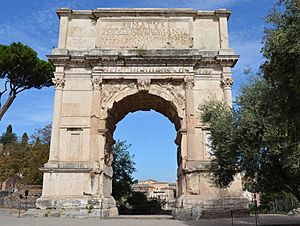
Titus is seen as one of the best emperors by ancient historians. All the writings from his time, many by people who knew him, speak very highly of Titus. His character is often seen as much better than that of his brother Domitian.
The Wars of the Jews gives a firsthand account of the Jewish rebellion and Titus's character. However, the author, Josephus, owed a lot to the Flavian family. In 71 AD, he came to Rome with Titus. He became a Roman citizen and took the Roman names Flavius and Titus from his supporters. He received money every year and lived in the palace.
Josephus wrote all his known works in Rome, with support from the Flavians. The War of the Jews often portrays the Jewish rebellion as weak and disorganized. It even blames the Jewish people for starting the war. Because of this, Josephus's honesty as a historian has been questioned.
Another writer from Titus's time was Publius Cornelius Tacitus. He started his public career in 80 or 81 AD and thanked the Flavian family for his rise. His work, The Histories, was published later. Sadly, only the first five books of this work have survived. The parts about Titus's and Domitian's reigns are lost.
Cassius Dio wrote his Roman History over 100 years after Titus died.
Pliny the Elder, who died during the eruption of Mount Vesuvius, dedicated his book Naturalis Historia to Titus.
While Roman histories show Titus in a good light, Jewish memory remembers "Titus the Wicked" as a cruel ruler who destroyed the Temple.
Titus in Later Art and Stories
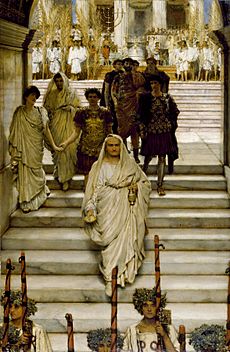
The war in Judaea and Titus's life, especially his relationship with Berenice, have inspired many writers and artists over the centuries. The carvings on the Arch of Titus have influenced how the destruction of Jerusalem is shown. The Menorah is often used to symbolize the treasures taken from the Second Temple.
Books and Plays
- Bérénice, a play by Jean Racine (1670), focuses on the relationship between Titus and Berenice.
- Tite et Bérénice, a play by Pierre Corneille, also from 1670, is about the same topic.
- Titus and Berenice, a 1676 play by Thomas Otway.
- La clemenza di Tito, an opera by Mozart, is about a plot to kill Emperor Titus.
- The Josephus Trilogy, novels by Lion Feuchtwanger, are about the life of Flavius Josephus and his connection with the Flavian family.
- Der jüdische Krieg (Josephus), 1932
- Die Söhne (The Jews of Rome), 1935
- Der Tag wird kommen (The day will come, Josephus and the Emperor), 1942
- The Marcus Didius Falco novels take place during Vespasian's rule.
- Titus is an important character in "The Pearl-Maiden", a novel by H. Rider Haggard, published in 1901.
Paintings and Visual Arts
- The Destruction of Jerusalem by Titus by Wilhelm von Kaulbach (1846). This painting shows the destruction of Jerusalem, with Titus as a central figure.
- The Destruction and Sack of the Temple of Jerusalem by Nicolas Poussin (1626). It shows the Roman army, led by Titus, destroying and looting the Second Temple.
- The Destruction of the Temple of Jerusalem by Francesco Hayez (1867). This painting also shows the Roman army destroying and looting the Second Temple.
- The Siege and Destruction of Jerusalem by the Romans Under the Command of Titus, A.D. 70 by David Roberts (1850). It shows Jerusalem burning and being looted by the Roman army under Titus.
- The Triumph of Titus and Vespasian by Giulio Romano (1540). This painting shows Titus and Vespasian riding into Rome in a victory chariot. They are followed by a parade carrying treasures from the war in Judaea. The painting incorrectly includes the Arch of Titus, which was built later.
- The Triumph of Titus by Lawrence Alma-Tadema (1885). This painting shows Titus and his family in a victory parade. Alma-Tadema was known for his careful historical research.
- Rear Panel of the Franks Casket. This early 8th-century carving shows Titus leading the Roman army into Jerusalem and capturing the Temple.
Images for kids
See also
 In Spanish: Tito para niños
In Spanish: Tito para niños




